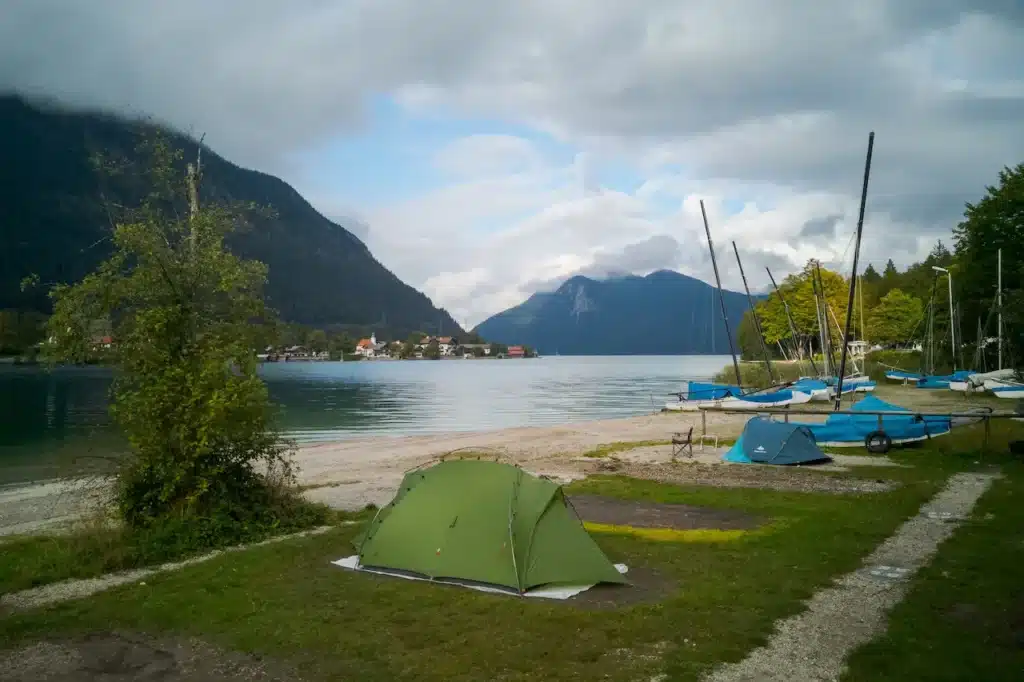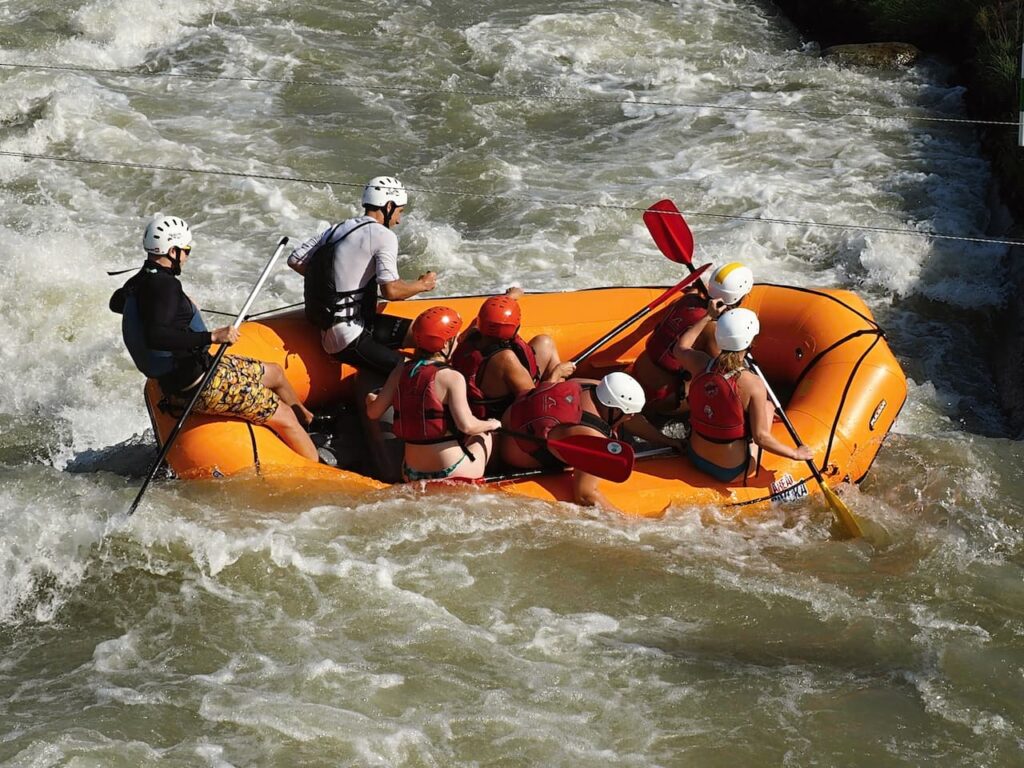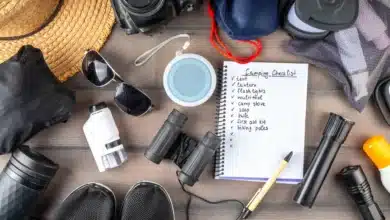Walchensee Camping? Walchensee is the perfect place for you to relax and enjoy a camping trip. You’ll find everything you need here, from the best camping sites to the most exciting outdoor activities.
Do you want to take a break from your everyday stress and relax by the lake? Camping at Walchensee could be the perfect thing for you. The location is a perfect combination of adventure and relaxation, with its turquoise water and stunning mountain backdrop. This blog post will tell you everything you need to know about camping in Walchensee, from the best campsites and how to reach them to nearby activities and excursions.
Camping in Walchensee: Your New Favourite Place in the Bavarian Alps
You can be in the middle of nature, only 75 km from Munich! Lake Walchensee is the largest Alpine lake in Germany, with an area of 16 square kilometres in Upper Bavaria, in the Two Lakes Region. The deep blue colour and surrounding mountain scenery make it a popular place for outdoor enthusiasts, nature lovers, and other outdoor enthusiasts. It has earned the nickname “Bavarian Caribbean”. It is also renowned for its high-quality water, which is perfect for summer swimming and watersports. The lake is surrounded by charming villages like Kochel am See and Walchensee. As an aside, compared to Walchense, the camping at Lake Riegsee is more of a secret tip but still worth visiting!

Easy and Simple to Get to the Camping at Walchensee
Want to go on a road trip spontaneously? Rent an off-road campervan in Nuremberg or Munich. You can reach Walchensee from Munich easily via the A95 and B11 motorways.
Walchensee 3 of the Best Camping Sites
We can recommend these places for camping on Lake Walchensee with views of the lake and mountains:
Campingplatz Walchensee 1, Camping Walchensee, is a family-run campground nestled into the mountains on the shores of Lake Walchensee. Over 100 campsites and pitches are available, with more than half being right on the water.
Campingplatz Walchensee2: Camping Kesselberg: You can find a comfortable home on wheels on the Kochelsee nearby, with a mountainous panorama that is no less spectacular. You can also enjoy Bavarian specialties in the beer garden. Or both!
The small, but very beautiful Renken campsite is located right on Kochelsee. The campsite offers 40 pitches as well as three rental caravans to short-stay tourists who want the camping experience.
Walchensee Activities
You will never get bored here! Lake Walchensee is a great place to do all sorts of things. There is something for everyone, from swimming and sunbathing at the lakeshore, to water sports, cycling and hiking, to cultural sites. You should try these seven activities when camping on Walchensee.
The Mountain is Calling for Hiking and Mountaineering!
There is something for everyone in the area surrounding Lake Walchensee, from easy hikes to more challenging summit tours. Here are a few of the most beautiful hiking routes in the area:
Walchensee Circular Hiking Trail. With views of Kochelsee and Walchensee, you feel like you are hiking alone. Even more so if you stop by the stunning Jocheralm.
Summit Tour to Heimgarten and Herzogstand: This challenging route will take you to Herzogstand, at 1,731 meters. You’ll be rewarded with a stunning view of Lake Walchensee.
Hike up to the Jochberg. The route to the Jochberg (1,565 meters) is one of the most popular hikes of the Bavarian Pre-Alps. It should be on your hiking list!
Explore the Lake by Mountain Bike and Cycling!
By bike, you can explore the area around Lake Walchensee. Many routes are available for both beginners and experienced cyclists. With breathtaking mountain views, adrenaline and great mountain views, each tour is an adventure.
Walchensee Circular Tour: A route for an easy day of cycling, with the option to stop at any beautiful place.
Walchensee Round Tour Light on the Southern Shore: In just an hour and a half, you can cycle through the most beautiful section of the Walchensee tour. This leaves more time to enjoy a relaxing break!
Isarblick cycle tour, you will enjoy the beautiful views along the Isar on your way to the shores of Lake Walchensee. You will be amazed, but you may also have sore muscles.

Enjoy the Water Sports!
All water sport enthusiasts must visit Lake Walchensee! You can let your hair down here by sailing, windsurfing or kayaking. How about paddling across the turquoise waters on a SUP board? You can hire watersports equipment at these locations.
Grab Your Camera and Start Shooting!
Lake Walchensee is a beautiful place to capture with your camera. The combination of the crystal-clear waters, lush forests and impressive mountain panoramas offers countless themes. These hikes offer the best views of Lake Walchensee.
Find your inner Zen with Yoga at the Lake!
Find your inner centre on the shores of Lake Walchensee. You will be able to relax in the fresh mountain air and enjoy the beautiful scenery. The down dog offers summit Yoga. A special gondola will take you up to the top of the mountain at 7:30 am. After a 40-minute hike, you can enjoy an hour of yoga in the lofty heights.
Discover Bavarian Culture
Visit the local sights to learn more about Bavarian history and culture, such as the Glentleiten Open-Air Museum and the nearby Benediktbeuern Monastery. You can try out something new by visiting the Farmers’ Theatre or taking a Guided Art Walk.
Camping Walchensee – Excursions Around the Area
You can discover many other places around Lake Walchensee. Five ideas for short trips around the lake:
- Neuschwanstein Castle – The Disney castle you’ve always dreamed of in real life. Neuschwanstein Castle, a famous castle in the area of Walchensee, is well worth a visit.
- Murnau am Staffelsee – Explore the beautiful little town of Murnau am Staffelsee and immerse yourself in the culture and art of the region. Enjoy the charm of one of the cute cafés.
- Partnachklamm: A nature and hiking experience awaits you in the Partnachklamm gorge in Garmisch-Partenkirchen. The deeply carved gorge offers spectacular views and is a must-see for mountain enthusiasts.
- Linderhof Castle – You can also immerse yourself in the world of King Ludwig II by visiting the magnificent Linderhof Castle. The castle is less crowded than Neuschwanstein Castle.
- Innsbruck – Take a trip to Innsbruck, the capital of Tyrol. It is known for its beautiful alpine scenery, historical architecture, and cosy, lively atmosphere.
Conclusion
Camping at Walchensee will be an unforgettable experience for outdoor enthusiasts and nature lovers. Lake Walchensee is a camping paradise with its scenic landscapes, many leisure activities, and cozy campsites. Walchensee is the perfect place to enjoy nature and to do all kinds of activities, including hiking, swimming, sailing, or just relaxing. Grab your camping gear and a campervan, then head to Walchensee. We’re off!



